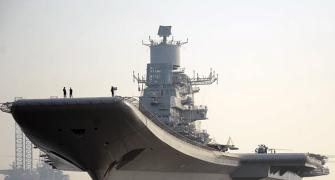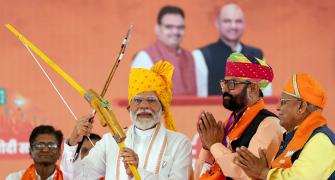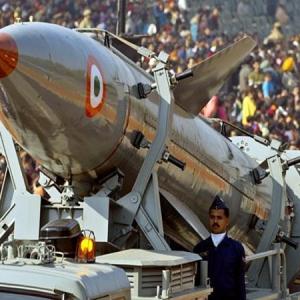The Indian Army, placing traditional weapons above high-technology, says that equipping the army's 800-plus combat units with a Battlefield Management System would cost an unaffordable Rs 500 billion to Rs 600 billion, reveals Ajai Shukla.

On July 27, the army officially shut down a project that was aimed at transforming it into a 21st century force, which leverages digital communications and information technology to swiftly detect, identify and destroy its foes.
Senior generals, including the army's vice-chief, want to scrap the revolutionary Battlefield Management System to save Rs 30 billion it will cost to develop.
Instead, they want legacy weapons like rifles and light machine guns.
The official foreclosure of the BMS project was declared last Friday, ironically, by the Defence Production Board -- a defence ministry body charged with promoting the development of futuristic defence platforms.
The battlefield efficacy of a digitally networked force was first demonstrated in the 1991 Gulf War, when Saddam Hussein's vaunted Iraqi army was overwhelmed in 96 hours by a United States military that had married sensor technology with real-time networking, across combat and support units.
Stunned by that demonstration of force application, all major militaries began developing networked battlefield systems.
A Chinese version of BMS, the Qu Dian, began deployment a decade ago.
Pakistan is developing its own BMS, named Rehbar.
But the Indian Army, placing traditional weapons above high-technology, says that equipping the army's 800-plus combat units with BMS would cost an unaffordable Rs 500 billion to Rs 600 billion, going by prototype development costs.
Industry sources counter that prototype development costs far more than industrial production, where scale would dramatically drive down prices.
After the BMS project was okayed in 2007, the defence ministry chose two Indian consortia to develop competing versions of the BMS.
In one, Tata Power (Strategic Engineering Division) is partnering L&T, while Bharat Electronics has joined hands with Rolta India in the other.
The BMS project is one of only three 'Make' category platforms that India's defence industry has been asked to develop, with the defence ministry reimbursing 80 per cent of the costs.
BMS seeks to leverage India's IT skills and talent to equip individual soldiers and commanders -- each carrying a high-tech 'software defined radio' -- as 'digital entities' that can receive information from battlefield sensors, such as unmanned aircraft, radars, ground sensors and lookout posts.
In turn, each soldier transmits battlefield information in front of him, feeding into a comprehensive 'battlefield picture' available to every combatant.
The principle on which BMS works is the same as Google Maps, which gets drivers to their destinations quicker by 'crowdsourcing' traffic information from numerous sources, including drivers' mobile phones.
BMS similarly 'crowd-sources' battlefield information from its own soldiers, through their SDRs.
A networked military is faster on what military jargon calls the OODA loop -- the cycle of observing (detecting the enemy), orienting (locating him), deciding (the type and location of a weapon to engage him most effectively) and acting (to launch the weapon to destroy the enemy).
Engagements are usually won by the force that 'closes the OODA loop' quickest. That is what the BMS enables.
An industry executive says the technologies that would be developed for BMS -- which involve connecting numerous entities on a single network -- are the same as those that drive an Internet of Things.
"BMS would galvanise IoT knowhow in India. This would be a classic case of technology 'trickle-down' from defence to civilian applications," he says.
Paradoxically, BMS, which networks the army's frontline combat echelons, is being shut down even as work continues on networking higher headquarters through projects like the Tactical Communications System, Command Information and Decision Support System, Artillery Command, Control and Communications System and Battlefield Surveillance System.
Junior army officers, who are far more tech-savvy than the digitally-uncomfortable generals, scoff at the logic of a 21st century command and control network that controls an old-style combat force.
"Every military worth its salt will be networked in a decade or two. We will have no choice but to be networked too. Foreclosing BMS today will only mean that, instead of Indian companies, it will be the Israelis or the Americans who network us," says an officer who is part of BMS.











